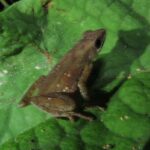- Introduction: Meet the Hidden Jewel of Brazil's Atlantic Forest
- Taxonomy and Classification: A Distinct Member of the Amphibian Family Tree
- Natural Habitat: Life Amid the Emerald Shadows
- Physical Characteristics: A Master of Camouflage and Secrecy
- Behavior and Life Cycle: Secrets Beneath Leaf Litter
- Ecological Role: A Vital Link Within the Forest Community
- Threats and Conservation Status: Preserving the Tiny Forest Guardian
- Cultural and Scientific Significance: More Than Just a Frog
- Conclusion: Safeguarding the Future of <em>Ischnocnema paranaensis</em>
Introduction: Meet the Hidden Jewel of Brazil’s Atlantic Forest#
Hidden amidst the lush, emerald tapestry of Brazil’s Atlantic Forest exists a remarkable, yet little-known creature: Ischnocnema paranaensis. Though inconspicuous in appearance, this elusive forest frog captivates researchers and wildlife enthusiasts alike. Its modest coloration and secretive behavior belie a fascinating ecological tapestry worthy of closer exploration.
Belonging to the family Brachycephalidae, Ischnocnema paranaensis is more than just a scientific curiosity. It’s a subtle yet crucial component in the vibrant web of organisms densely populating one of Earth’s richest biodiversity hotspots. With each passing day, as we learn more about this diminutive amphibian, we are reminded of how even the humblest species can play an outsized role in ecosystem health and stability.
Taxonomy and Classification: A Distinct Member of the Amphibian Family Tree#
Ischnocnema paranaensis, first described in scientific literature in 1996 by Langone and Segalla, belongs to the vast and diverse amphibian order Anura—the frogs and toads. Within Anura, it falls under the family Brachycephalidae, a group characterized by diminutive size and terrestrial habits. Its genus, Ischnocnema, includes several cryptic species difficult to distinguish without detailed morphological or genetic analysis.
This species’ classification underscores the intricate biodiversity puzzle that Brazil’s much-threatened Atlantic Forest continues to reveal. Its nearest relatives, such as Ischnocnema henselii and Ischnocnema guentheri, share similar evolutionary histories characterized by adaptations suited for life hidden among leaf litter and dense vegetation.
Natural Habitat: Life Amid the Emerald Shadows#
Endemic to the southern regions of Brazil, specifically the Paraná region, Ischnocnema paranaensis lives exclusively in carefully balanced microhabitats within the Atlantic Rainforest. These habitats, often located at elevations between 400 and 800 meters, consist predominantly of humid montane forests—environments rich in moisture, leaf litter, and dense undergrowth.
The Atlantic Forest, which once stretched from coastal Brazil through Argentina and Paraguay, has faced dramatic reductions due to deforestation, agricultural practices, and urbanization. Amid this fragmented biome, our tiny amphibian resides in remnant forest patches where moisture remains constant, crucial for its highly sensitive terrestrial skin.
Unlike many amphibians reliant upon streams or ponds, Ischnocnema paranaensis prefers terrestrial living, inhabiting damp logs, mosses, and leaf-litter floors. The moist, shaded understory offers camouflage and plentiful food sources, perfectly aligning with the frog’s evolutionary adaptations.
Physical Characteristics: A Master of Camouflage and Secrecy#
At first glance, Ischnocnema paranaensis appears indistinct, draped in shades of earthy browns, reddish-browns, and occasional olive greens. Measuring only approximately 2 to 3 centimeters in length, this tiny amphibian showcases a compact, robust body with short limbs particularly suited for quick, short hops through dense leaf litter.
Its coloration and patterning—often mottled or speckled—provide impeccable camouflage against the forest floor, helping evade predators such as snakes, nocturnal mammals, and predatory birds. Their cryptic appearance perfectly mirrors leaf debris and vegetation, rendering them practically invisible to both predators and casual observers.
Beyond appearance, their skin texture plays a crucial role. Slightly granular and moist, their skin helps retain moisture for cutaneous respiration. This physiological adaptation is essential for life in an environment often subjected to rapid climatic fluctuations.
Behavior and Life Cycle: Secrets Beneath Leaf Litter#
Feeding Ecology and Hunting Strategies#
Ischnocnema paranaensis is primarily insectivorous, preying upon small arthropods, insects, mites, and spiders unearthed among leaf litter or beneath decaying logs. Utilizing keen eyesight specialized for dim conditions, alongside their sensitive tactile capabilities, these frogs patiently wait for unsuspecting prey before rapidly striking with their sticky, muscular tongues.
Unique Reproductive Habits#
Unlike many frogs, members of the genus Ischnocnema showcase terrestrial reproductive behaviors. Remarkably, Ischnocnema paranaensis deposits eggs directly within damp soil and leaf litter rather than in water bodies. Here, fully formed juvenile frogs hatch directly from eggs, bypassing the typical tadpole stage seen in aquatic breeders—a phenomenon known as direct development.
This remarkable adaptation greatly enhances survival prospects within fragile habitats, reducing dependency on permanent water sources. The parents offer no direct parental care post-oviposition, yet the careful selection of suitable egg deposition sites greatly influences juvenile survival rates.
Ecological Role: A Vital Link Within the Forest Community#
Ischnocnema paranaensis, although minuscule and easily overlooked, plays an indispensable ecological role. Predominantly insectivorous, this frog species contributes significantly to controlling insect populations, thus regulating insect-driven decomposition processes.
Additionally, as potential prey themselves to a variety of vertebrate predators, their presence sustains higher trophic-level species. Their sensitive nature renders them invaluable bioindicators—signaling changes in environmental quality, habitat health, and detecting early ecological disturbances caused by environmental factors like pollution or climate alteration.
Threats and Conservation Status: Preserving the Tiny Forest Guardian#
Ischnocnema paranaensis faces significant conservation concerns, primarily due to ongoing habitat degradation within its limited geographic range. The relentless encroachment of agriculture, cattle pasture expansion, urbanization, and logging activities has fragmented and reduced their habitats substantially. Climate change adds further unpredictability, altering rainfall patterns and reducing humidity, critical for this frog’s survival.
Currently, the International Union for Conservation of Nature (IUCN) classifies Ischnocnema paranaensis as “Data Deficient,” chiefly owing to scarce specific population studies. Its cryptic nature makes population surveys challenging, resulting in severely limited information regarding exact numbers, trends, and long-term viability.
Fortunately, some conservation initiatives within regions like Paraná actively promote forest preservation, habitat restoration, and reforestation programs. Continued research, monitoring, and effective forest reserve management will prove fundamental to the survival of this delicate amphibian species.
Cultural and Scientific Significance: More Than Just a Frog#
Though lacking widespread cultural recognition, species like Ischnocnema paranaensis profoundly influence our scientific understanding regarding amphibian evolution, ecology, and conservation biology. Their terrestrial breeding and direct development strategies inform amphibian developmental biology studies, biodiversity conservation, and ecosystem health assessments.
This secretive little frog symbolizes the intricate interconnections among species and the often-unseen roles they play within biodiversity hotspots like Brazil’s Atlantic Forest. Protecting its habitat safeguards countless other species sharing similar ecological niches.
Conclusion: Safeguarding the Future of Ischnocnema paranaensis#
Though small and seldom encountered, the hidden wonders of Ischnocnema paranaensis underscore its intrinsic ecological, scientific, and conservation value. Unraveling this tiny frog’s mysteries deepens our appreciation of biodiversity’s delicate interconnectedness, ultimately reinforcing the necessity of habitat preservation and responsible stewardship.
By supporting forest conservation initiatives, raising public awareness, and prioritizing environmental education, we can collectively work towards a future where species like Ischnocnema paranaensis continue to thrive. Every species saved enriches our planet’s extraordinary tapestry of life, revealing an endless array of biological wonders waiting patiently beneath every leaf.







